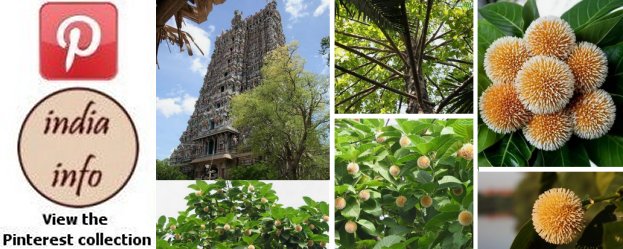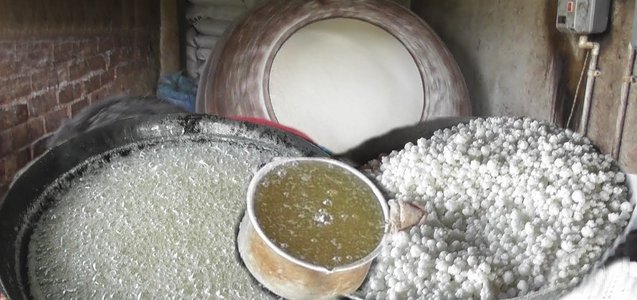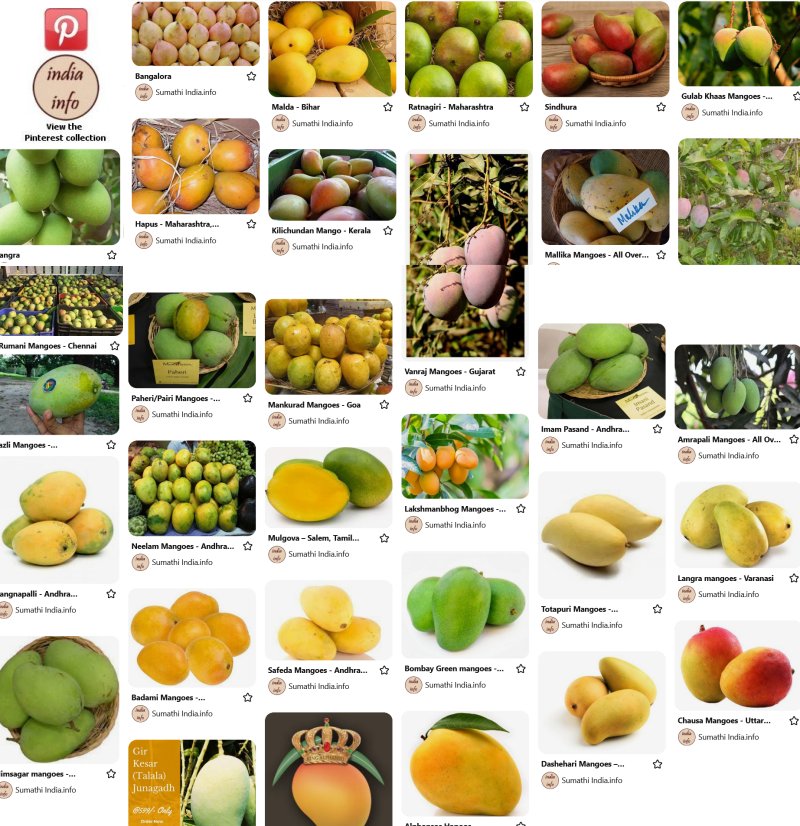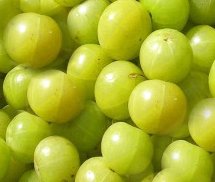Snippets of Information
Food / Herbs
* 19 Jan 2023

Maddur Vada (Vade) is a popular snack (crispy fried patties) from Karnataka, originating in Madduru, a town 85 kms south west of Bengaluru.
Main ingredients of Maddur Váda are rice flour, sooji rava and maida.
These ingredients are mixed with chopped onions, coriander leaves, green
chilies, curry leaves and mixed very well adding warm oil and water.
Salt and asafoetida (hing) are added too. Above mix of flour and add-ons
is deep fried in boiling oil till the colour turns brown to get crispy
and tasty Maddur Váda. Best place to have Maddur Váda is of course the
town of Maddur, which falls between Bengaluru and Mysuru.
Source: karnatakatourism.org
Maddur Vade was invented by Shri Ramachandra Budhya on a railway
platform, way back in 1917! Shri Budhya used to run Vegetarian
Refreshment Room (VRR) at Maddur railway station in 1917 to sell pakoras
and idlis. To meet customer's demands he tried out this dish which is
easy to make and requires less preparation time.
Source: adukale.com
* 18 Jan 2023

Kadamba, Bur flower, Kadam Tree
The Cadamba is commonly known as “Kadamba” in Sanskrit and Hindi and as
“Kodom” in Bengali. It is an evergreen tropical tree found in different
parts of India. The species has scented orange flowers present in dense
globe-shaped clusters, which are used in the preparation of perfumes. It
is an ornamental and shade giving tree that is also used for timber-
and paper-making. It has crucial significance in Indian mythology and
religion. Various religions in India have strongly believed that God
lives inside a Cadamba tree based on its enormous significance to
humankind. It has been said in the Sanskrit shloka, “Ayi Jagadamba
Mad-Amba Kadamba Vana-Priyavaasini Haasa-Rate,” that is, Goddess Durga
likes to live in the forest of Cadamba trees.
Flowering usually begins when the tree is 4-5 years old. The fruits of
the Cadamba are small, containing fleshy capsules packed closely
together to form a yellow-orange infructescence. The Cadamba has been
known to cure a number of diseases; particularly, the extract prepared
from the bark and leaves is crucial. Various researchers across the
world have focused their studies on discovering a number of
phytochemicals as well as secondary metabolites (saponins, indole and
quinoline alkaloids, secoiridoids, and triterpenes) with pharmacological
significance from the Cadamba.
Astroethnobotanical importance : According to mythology, the whole
universe is made of five elements or panchtatva (fire, earth, air, soil,
and water), including plants and animals. The vast Sanskrit literature
has affirmed that not only human beings but even minute creatures,
whether plants, animals, or microorganisms, are under the influence of
the forces of the planets. It is believed that each and every person
born on Earth belongs to any one of the 27 nakshatras (stars) present in
the universe. There are 27 stars, which are correspondingly correlated
to 27 trees present on Earth. This correlation signifies that humans are
directly related to plants. These 27 celestial plants have the power to
fight against the harmful effects of the planets on human lives. Plants
and herbs have been found to be extremely effective in neutralizing the
detrimental influences of the astral positions of stars. The Cadamba is
one of the trees enlisted, which resembles Satabhisha nakshatra. It has
been indicated in astrology that humans having Satabhisha as their
birth star should plant the Cadamba near their habitats, which would
help in curbing mental depression, heart attack, mood swings, laziness,
rudeness, etc.
Various parts of the Kadamba tree have been found to have
Antihelminthic, Antifungal, Antifilarial, Antimalarial, Antibacterial,
Antidiabetic, Antitumor, Analgesic, Anti-inflammatory, Antidiarrheal,
Hypolipidemic, Antihepatotoxic, Diuretic and laxative effects.
Source: ncbi.nlm.nih.gov - Cadamba: A miraculous tree having
enormous pharmacological implications by Alka Dwevedi, Kuldeep Sharma,
and Yogesh K Sharma
* 18 Jan 2023
Kadamba holds a place in many Indian mythological, folklore, and
historical literature. The Kadam tree connects with Lord Krishna, where
Radha and Krishna used to love to play under the shade of the hospitable
and sweet-scented Kadamba. Krishna also used to perform ‘Raas-Lila’
fascinating flute/Bansuri under the same tree in his younger days.
Bhagavata Purana mentions Kadamba and the Sangam period of Tamil Nadu
and cites Murugan [from Thiruparankundram- the Hill of Madurai] as an
attraction of nature worship that used to be spear-kind under Kadam.
- This plant also relates to Kadambariyamman [a tree deity].
- Kadamba tree yields fruit in May and is called the May tree.
- The Kadamba dynasty has named Kadamba as a holy tree.
- A yellow dye can be abstracted from the root bark of the Kadamba plant.
- Kadamba flower has multiple uses, including producing a sandalwood-based perfume named attar
Source: housing.com
* 18 Jan 2023
- The Tiruvilaiyadal Puranam refers to the Madurai city as ‘Kadambavanam’
- Kadamba also gets a place among the 99 flowers listed in Kabilar’s Kurinji pattu .”
- A song in Paripadal - ‘Urul inar kadambu’ - documents the ball-like blossoms of the tree.
- song no199 in Agananuru says how thirsty elephants mistake the soft
blossoms falling from the kadamba tree for a fine drizzle and run in
joy.
- the tree bears multiple fruit in which many flowers together produce a single fruit with multiple seeds in turn.
- Places such as Kadavur and Kadambur are named after the tree.
- The kadamba tree is associated with Lord Muruga, who’s also called Kadamban
Source: Where once stood a forest of kadamba trees... by A. Shrikumar, thehindu.com, Dec 7, 2018
* 18 Jan 2023
Madurai city was oncekonw as Kadamba vanam, forest of kadamba trees.
Chennai area is also said to have had an abundance of Kadamba trees.
Kadamba tree is the sthala vruksham of
Meenakshi Amman Temple. Kadamba tree can be seen near the West Gopuram
of Meenakshi Temple. A withered relic of this plant is sacredly
preserved in the temple area.
Source: housing.com
* 8 Aug 2022

Ceylon Pasalai Keerai (Talinum triangulare (Jacq.) Willd) is also known as kuthu pasalai keerai or water leaf. Pasalai
keerai is good for oral health. It cures dental problems like pyorrhea
by chewing raw. Produces blood cells, prevents throat and lungs cancer,
and normalizes magnesium content and stablises mind and body health
condition. Good for diabetes. It acts as a agent to destroy the unwanted
toxic substances in the stomach and it helps to reduce the blood sugar
levels by excess urination.
The magnesium is the needed mineral to maintain the blood sugar level
from too much fluctuation. The best medicine for constipation. Helps
prevents and cures sexually transmitted infections. It helps to reduce
the cholesterol and fat deposits in the valves that pumps the blood all
over the body.
Pregnant woman is advised to take for baby’s health and breast feeding.
The folate in pasalai keerai enhances the healthy growth of nervous
system, lungs growth in the fetus.
Source: fb-asucrepureherbals / indiabiodiversity.org / nimedhealth.com.ng
* 30 May 2022

In different parts of the world, several types of basil are cultivated,
some of the widely used varieties can be categorized in two groups -
holy basil (ocimum sanctum) and mediterranean basil (ocimum basilicum).
Holy basil
It is known as Tulsi and is the most revered houseplant, in India
it is associated with ayurveda and hindu religion as goddess of wealth,
health and prosperity. The plants have strong medicinal properties
compared to second group species. There are several varieties popular
based on the regional religious beliefs which are known by a several
vernacular and common names such as in Sanskrit it is named as Rama
Tulsi and Krishna Tulsi, in Malayalam it is called Trittavu, in Marathi
as Tulshi, Tulasi in Tamil, Thulsi in Telugu and Holy Basil in English.
Not to be confused with Ocimum Tenuiflorum, it is a synonym for Ocimum
Sanctum. There 4 species popular of Holy basil:
1. Rama tulsi (ocimum sanctum)
2. Krishna tulsi (ocimum tenuiflorum)
3. Amrita tulsi (ocimum tenuiflorum)
4. Vana tulsi (ocimum gratissum)
Mediterranean basil
It is known as Sweet basil and is the most popular variety of basil
which is found all over the world including Asia, Eurpe, America and
Africa. It is most consumed herb world wide and known by several common
names such as king of herbs, royal herb, great basil and
Saint-Joseph’s-wort etc, it is used in culinary preparations and used in
several types of popular cuisines like Italian, Thai etc.
5. Sweet basil (ocimum basilicum)
6. Thai basil (ocimum thyrsiflora)
7. Purple basil (ocimum basilicum)
8. Lemon basil (ocimum citriodorum)
9. Vietnamese basil (ocimum cinnamon)
10. American basil (ocimum americanum)
11. African blue basil (ocimum kilimandscharicum)
12. Italian genovese basil (ocimum basilicum)
13. Lettuce basil
14. Green ruffles basil
15. Cardinal basil
16. Greek basil
17. Spicy globe basil
18. Summer long basil
Source: mashrita.com
* 25 Aug 2021
Tulsi plant or Holy basil (Ocimum tenuiflorum)

Tulsi is considered sacred and most Hindu households with a backyard
have a Tulai Maadam and offer daily prayers. It also has great
medicianal value.
Green type (Sri Tulsi) and Purple type (Krishna Tulsi).
Tulsi has been used in Ayurveda for its diverse healing properties. Tulsi,
the Queen of herbs, the legendary 'Incomparable one' of India, is one
of the holiest and most cherished. The sacred basil, Tulsi, is renowned
for its religious and spiritual sanctity, as well as for its important
role in the traditional Ayurvedic and Unani system of holistic health
and herbal medicine of the East. It is mentioned by Charaka in the
Charaka Samhita; an Ayurvedic text. Tulsi is considered to be an
adaptogen, balancing different processes in the body, and helpful for
adapting to stress. Marked by its strong aroma and astringent taste, it
is regarded in Ayurveda as a kind of 'elixir of life' and believed to
promote longevity. Tulsi extracts are used in Ayurvedic remedies for
common colds, headaches, stomach disorders, inflammation, heart disease,
various forms of poisoning and malaria and is taken in many forms, as
herbal tea, dried power or fresh leaf. For centuries, the dried leaves
of Tulsi have been mixed with stored grains to repel insects.
Source: ncbi.nlm.nih.gov
Read more at swayamkatha.wordpress.com
* 2 Dec 2021
Nakul Dana

These sugar balls distributed as prasad in several temples is also known
as Sakariya, Chironji Dana, Elaichi Dana or Mimosa sugar balls.
A centrifuge machine is used to transform sugar syrup into balls. They
can be used in several recipes as alternate to sugar and also for
decorating.
Source: tarladalal.com, image - youtube
* 17 Nov 2021
Udupi hotels
This is not a chain of restaurants owned by any single person or institution.
Sri Krishna temple in Udupi was founded by Shri Madhvacharya, proponent
of the Dvaita (dualism) school of Vedanta in the 13th century. At
this temple, annadhanam was a regular practice. The cooks who were very
particular in their hygiene and cooking process, in course of time moved
to different parts of the country such as Chennai, Mumbai and opened up
hotels, which came to be known as Udupi hotels. They had several
specialised recipes but the most popular dishes are their masla dosas,
vadas and unique sambar.
* 1 Oct 2021

"More than just a fruit, mangoes are revealed as a symbol of fertility
and picking them from trees as the ultimate princely pastime. "The sweet
and delicious mango has always been the favourite fruit in history, as
it is now. Shah Jahan had his mangoes from the Konkan coast couriered
regularly to the imperial kitchens in Delhi while his grandfather Akbar
had a mango grove, Laakhibagh in Darbhanga specially planted with a
hundred thousand choice mango trees," note the creators of Arts of
Hindostan, as they put together a selection of artworks from Mughal
Lucknow and Farrukhabad schools, the Rajput schools at Bundi and
Bikaner, the early Deccan school at Golconda and the Company School at
Calcutta, spread across three centuries."
Source: architecturaldigest.in
* 1-2 Sep 2021
Mango varieties in India

Alphonsos, Amrapali, Badami, Banganapalli,
Bombay Green mangoes,
Chausa,
Dashehari,
Fazli,
Gulab Khaas,
Hapus,
Himsagar,
Imam Pasand,
Kalapadi,
Kesar,
Kilichundan, Lakshmanbhog, Langra,
Malda,
Mallika,
Mankurad,
Mulgova,
Neelam,
Paheri/Pairi,
Raspuri,
Ratnagiri,
Rumani,
Safeda,
Sindhura, Totapuri,
Vanraj.
More details on region and quality
Source: mangoesmumbai.com ; holidify.com ; timesofindia.indiatimes.com ; gardendiary.info
* Jul 2021
Herbs associated with the Pancha Boothams
Land (Nilam in Tamil) - Arugampul (arugam grass)
Water (Neer in Tamil) - Maavilai (mango leaf)
Fire (Neruppu in Tamil) - Vaazhai ilai (banana leaf)
Wind (katru in Tamil) - Vepilai (neem leaf)
Sky (Agaayam in Tamil) - Vetrilai (Paan leaf)
* Jul 2021
Amla

Amla is Indian gooseberry (Emblica officinalis) (Nellikai, nellikani in
Tamil), a fruit found mainly in India. It is a greenish yellow fibrous
fruit about an inch or two in diameter, round shaped with vertical
stripes. It simultaneously tastes sweet & sour. It is rich in
natural vitamin C. It is used in making ayurvedic medicines, tonics for
it has several positive qualities - cooling, diuretic and laxative
properties, strengthens teeth and bones, antioxidant and
antibacterial properties. It aids in maintaining clear skin &
healthy growth of hair. It is eaten raw with salt and is also used to
make pickles.
* Jul 2021
Mango Day
The U.S. India Business Council in Washington, D.C. played host to the
first-ever 'Mango Day' celebrations on the arrival of Indian mangoes to
the U.S., after a gap of 18 years. The first mangoes arrived at the John
F. Kennedy Airport in New York. But the big welcome party occurred in
the nation's capital.
Reference: voanews.com
*
Jul 2021
Condiments and Nuts
|
English
|
Tamil
| | Aniseed
| Sombu
| | Asafoetida
| Perungayam
| | Almonds
| Badam Parappu
| | Arrow Root
| Koovak Kilangu
| | Bay Leaf
| Punnai Ilai
| | Black Pepper
| Milagu
| | Cardamom
| Yelakkai
| | Cinnamom
| Pattai
| | Cloves
| Lavangam
| | Coriander Seeds
| Vara Kothamali
| | Cumin Seeds
| Jeeragam
| | Curry Leaves
| Kariveppilai
| | Cashew Nuts
| Mundhiri
| | Dry Ginger
| Sukku
| | Femmel
| Perunjeeragam
| | Feenugreek
| Vendhayam
| | Garlic
| Vellai Poondu
| | Ginger
| Ingi
| | Groundnuts / Peanuts
| Verkadalai
| | Jaggery
| Vellam
| | Lemon Rind
| Yelumichai Thol
| | Mace
| Jadhipathiri
| | Mango Powder
| Mangai Podi
| | Mustard
| Kadugu
| | Nutmeg
| Jadhikkai
| | Poppy Seeds
| Kasa Kasa
| | Roasted Gram
| Pottu Kadali
| | Red Chillies
| Sigappu Milagai
| | Raisins
| Ularndha Dhirakshai
| | Rice Flakes
| Arisi Avial
| | Sesame Seeds
| Ellu
| | Saffron
| Kungumapoo
| | Sugar Candy
| Kalkandu
| | Tamrind
| Puli
| | Turmeric Powder
| Manjal Podi
| | Tymol Seeds
| Omam
|
* Jul 2021
Jhavvaadhu powder is a perfume made out of a blend of sandal wood powder, sandal wood oil and floral extracts.
|